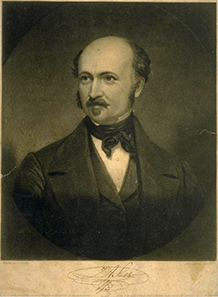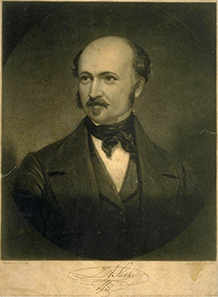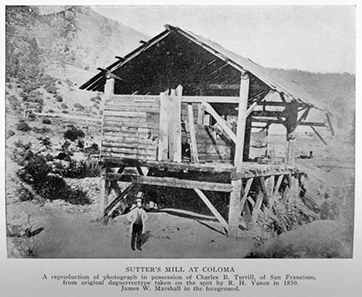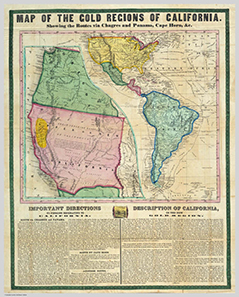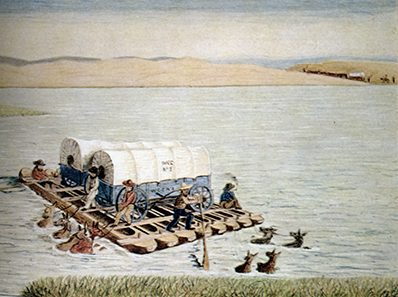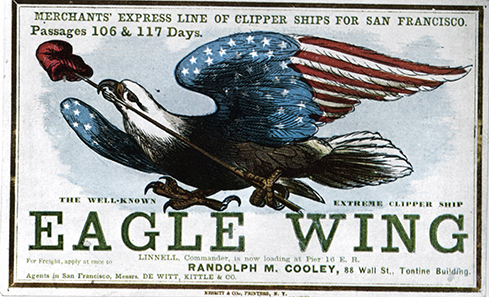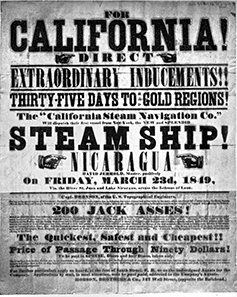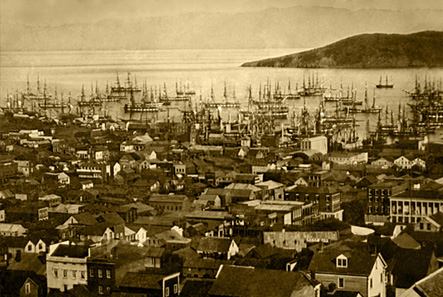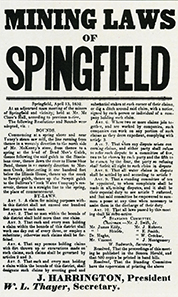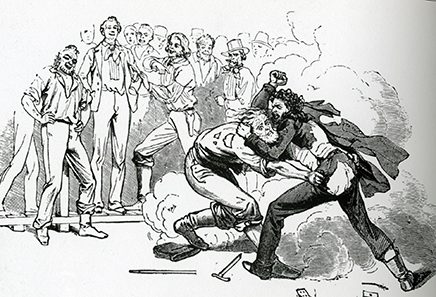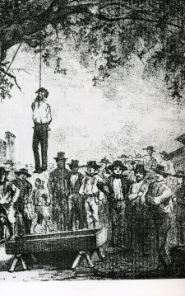Gold rush in California: part I
On 15th March 1848, a local newspaper in California, which had just been acquired by the United States of America, published an eleven-line note: “Gold Mine Found. In the newly made raceway of the Saw Mill recently erected by Captain Sutter on the American fork, gold has been found in considerable quantities. One person brought thirty dollars worth to New Helvetia, gathered there in a short time. California, no doubt, is rich in mineral wealth, great chance here for scientific capitalists. Gold has been found in almost every part of the country.” That, however, was grossly exaggerated, on 15th March 1848 at least. At that time, California still was more like hicksville, province at the borderline of the United States, on whose vast territory lived 14,000 or so people who lived on husbandry for the most part.
John Augustus Sutter. *28th February 1803, Kandern / Baden-Wurttemberg, + 18th June 1880, Washington D. C.
This was where the farm of Captain John August Sutter. He was born in Kandern / Baden as the son of Swiss parents and came to the USA in 1839, flat broke. The first years of his biography actually sound like the American Dream. Admittedly, Sutter didn’t work as dishwasher, but the foundation of his fortune was 500 dollars he had earned as a price fighter. Thanks to hard work and a good gut feeling when it came to business, he managed to buy an area in unpeopled California only a few years later almost half as big as Switzerland. No one really cared for that ground since it was pretty dry. By damming up the countless rivers in the area Sutter was able to create an agricultural paradise in which he had settlers from Germany and Switzerland sent.
Sutter’s mill in Coloma, where carpenter James Marshall found the first gold in the mill’s ditch.
The first gold find
This paradise was positively awaken on 24th January 1848 by the news that James Wilson Marshall had found two little flakes of gold in the river bed when inspecting the water course of the newly built mill. Sutter tried to limit the damage. He asked all parties involved to not breathe a word. But who could have kept such a thing a secret? Word, however, spread quickly. Only six weeks after the find literally all workers had left Sutter’s farm to search for gold on his grounds. Four months later, the population of San Francisco had been diminished, from several hundred people to roughly one dozen. The above cited newspaper stopped working with the following headline: “The whole country (…) resounds with the cry of ‘gold, GOLD, GOLD!’ while the field is left half planted, the house half built, and everything neglected but the manufacture of shovels and pickaxes.”
News reaches the east
Of course, these events aroused the government’s interest. The governor of California, Colonel George Mason, departed in June 1848 on an inspection tour in order to find out if there the rumors were true. He visited the gold fields and saw 4,000 or so gold diggers who for gold worth 30,000 and 50,000 dollars each day. A detailed report of the governor to the government in Washington was finished on 17th August. To enhance its credibility, he added a tea box containing gold worth 3,900 dollars. His consignment reached the capital in the end of June 1848.
The report arrived at the right moment for the politicians, most notably President James Knox Polk. California was in the possession of the United States for only one year. It had taken a war and a purchase price of 15 million dollars to get the country from Mexico. In the north, people hadn’t been too happy about it. For one thing, they were offended by the high costs, for another thing they feared that California might take sides with the slaves keeping states in the south.
Contemporary map of the Californian gold fields from 1849.
The governor’s report provided points for justifying the government’s policy. One sentence is especially likely to have pleased the president. Mason wrote: “I have no hesitation now (after inspecting the gold fields, author’s note) in saying, that there is more gold in the country drained by the Sacramento and San Joaquin Rivers than will pay the cost of the present war with Mexico a hundred times over.”
Hardly surprising that all of a sudden all newspapers published lengthy articles which praised the gold finds in California enthusiastically – and exaggerated a bit here and there. The people of the east coast gorged themselves on the reports on the ‘Wild West’ and flocked into lectures of self-proclaimed mining experts. One of them told in New York, that 100,000 people in ten or twelve years wouldn’t exhaust the Californian gold resources, that Californian gold miners would earn as much as 1,000 dollars each day, that one differ would have found 36 pounds of gold – hence gold worth 9,000 dollar – on a single day, another 12,000 dollars in six days and that he himself would have seen gold nuggets weighing 7 pounds.
It can easily imagined, that the prospect of such massive profit brought adventurous men to California. At the beginning of 1849, the inhabitants of California had almost doubled, 92,000 people lived there in 1850, 255,000 people in 1852, and 380,000 at the end of the decade. It was mostly young men who came, and they were by no means poor. The trip from the east to the Holy Land was expensive. Only successful farmers, tradesmen or intellectual people like lawyers and doctors could afford it.
Joseph Goldsborogh Buff crosses a river with his prairie schooner on his way to California in 1849.
The voyage
Travelers could choose between three itineraries. There was the route straight across the continent, overland following the trails, that was also used by the emigrants into the west. That itinerary had two great disadvantages: it was strenuous and dangerous. On the other hand, it was cheap, cheaper at least than the other two options. The prospective gold diggers nevertheless needed supplies and equipment, a prairie schooner to store it plus the required draft animals.
Advertising poster for a tour around Cape Horn in 106 & 117 days.
The second option was going by sea around Cape Horn, where 13,000 sea miles were to be weathered. However, the traveler arrived at his destination after six months already, which was much faster than the overland route. The sea tour, on the other hand, cost 300 dollar at least. The trip wasn’t as strenuous as the overland tour, but the gold diggers were forced to deal with confined space, bad food and seasickness, too.
Advertising poster for a passage from New York to San Francisco via Nicaragua.
Particularly bright ones tried a combination of land and sea trip. They went by boat to the neck of Panama und crossed it, partly in logboats that were oared by natives, partly by foot. The passage was dangerous, many gold diggers died of cholera or malaria before they even reached California. But if a man stayed healthy he could have been at the Pacific coast in five days-time. Most of the ships that landed in Panama were full of gold diggers and didn’t want to take any more of these with them. The ones waiting had no other choice than pay excessive prices and bribes in order to take a step forward.
In the end of 1848 the gold finds had been publicized in the east, in 1849 the first gold diggers arrived. Following that, they were called ‘Fortyniners’.
Trading vessels in the San Francisco port around 1850.
The local situation
What situation did the Fortyniners meet? And who did they deal with it? How is it possible that they dug wherever they thought gold was located, without paying any reference to ownership? How come that a rich man like Sutter had no chance to defend his territory against those fast-approaching gold diggers? At this point, a little detour about the political situation back then is on order. After having being purchased, California obtained the status of territory of the United States of America, which, however, didn’t mean that it was on a par with the members of the union of states legally. They possessed their own constitution and a limited home rule, and in addition they had their own government with an elected governor. The governor of California, in contrast, was appointed by the central government as administrator. There was no developed executive authority with police and security personnel. The army, small as it was in the first place, melted away, because many soldiers deserted to the gold fields. Thus, California lacked the stable legal relationships common in the east.
Sutter’s vast territory, on which the first gold had been found, naturally had a particular appeal to the ones looking for gold. Sutter tried to defend himself from that by appealing to the governor for the protection of his possessions. He gave evidence to the official that he had bought his territory from the former owner in accordance with the law. But the new Mexican governor didn’t acknowledge his claim. The officer clearly realized that he couldn’t provide any effective protection and didn’t want to compromise the government by its utter failure. The right of the possessors on their possessions was rendered inoperative, at least at the beginning of the gold rush.
The laws of the Springfield gold diggers. They had been published in such a rush that the printer even misspelled the city name.
Grassroots democracy and lynch law
The gold diggers thought that most handy. They created their own laws and administration. Notably in the first two years of the gold rush a well-operating grassroots democracy system came into being: when the number of gold diggers rose to such an extent that oral agreements were no longer possibly a meeting was called where first of all the borders of the district were defined for which the agreements would apply. Then the size of the individual claim was defined, how many claims one gold diggers was allowed to have, as well as other modalities. An officer for special tasks was elected and the penalty laid down that was to be inflicted in case of contraventions.
Defining a claim was easy. There was no legal knowledge required to the certificate of ownership.
A claim was a demarcated piece of ground a gold digger was allowed to exploit. For defining it, wooden poles were banged in at the corners, with notes attached stating to which that claim belonged. Such a claim could be sold and acquired, but in the majority of cases every man was allowed to possess one only, and the legal right was valid only for as long a gold digger exploited his claim. If he continued on or didn’t work on it for extended periods of time, another could claim it. When a gold digger left his claim for a short period of time, he nevertheless left his equipment on his grounds to sustain his claim. He who stowed away his things or took them with him wasn’t called a tidy fellow but a silly one.
Howard Gardiner, for example, a greenhorn who arrived in California in 1849 found gold after just a short time, together with his friends. But how disappointed where the newcomers once they returned from a trip to a near-by shop to ‘their’ grounds again only to find some other gold digger who had define their claim for himself. No tools had informed them that there were already others who exploited the ground. Hence, the greenhorns lost their promising claim and were forced to continue on.
Quarrel amongst gold diggers. Illustration by Charles Nahl 1856.
Such controversies not always had a happy ending. Every gold digger was armed and quite willing to enforce his right with a weapon in his hands. Generally speaking, however, one tried to establish a regular jurisdiction in the gold digger camps. When issues arose, a meeting of all citizens was called and a majority decision reached. And there was some kind of elected judge, the alcalde, who decided on the less significant violation of rights. In case of major violations, the gold diggers formed a jury, under leadership of the alcalde, which reached a verdict quickly and effectively – although not always fair – enforced it on the spot.
Lynch law: execution of Rafael Escobar, being convicted of murderer. He was the tenth man who was being lynched on that tree.
The only penalties available were beating, deportation or death because the camp didn’t have any prison. Notabene, this was the regular kind of jurisdiction. From times to time, on the other hand, lynch law was exercised with the mob without time-consuming taking of evidence tarred and feathered unpopular men, expelled them, or hanged them.
This unsettled legal situation only went as far as 1850. In that year, California had gained enough inhabitants to be accepted into the American confederation as new member. That took 65,000 inhabitants at least, and California already got 92,000. Especially the possessing social stratum, the tradesmen and investors, was interested in regular relationships and the protection of property. So, they made an effort to call a constitutional convention. Participating were merchants and dealers, farmers and lawyers. However, the largest segment of the population, i. e. gold diggers, weren’t represented. They lacked any interest in any kind of state control which is also testified by the voter turnout. Only 12,061 of the almost 100,000 registered voters made a statement about the constitution. That was highly unusual. For comparison: in the presidential election of 1840, 78% of the electorate in the entire state territory of the USA participated.
In upcoming part II you will learn what living and working in the gold fields truly was like.






